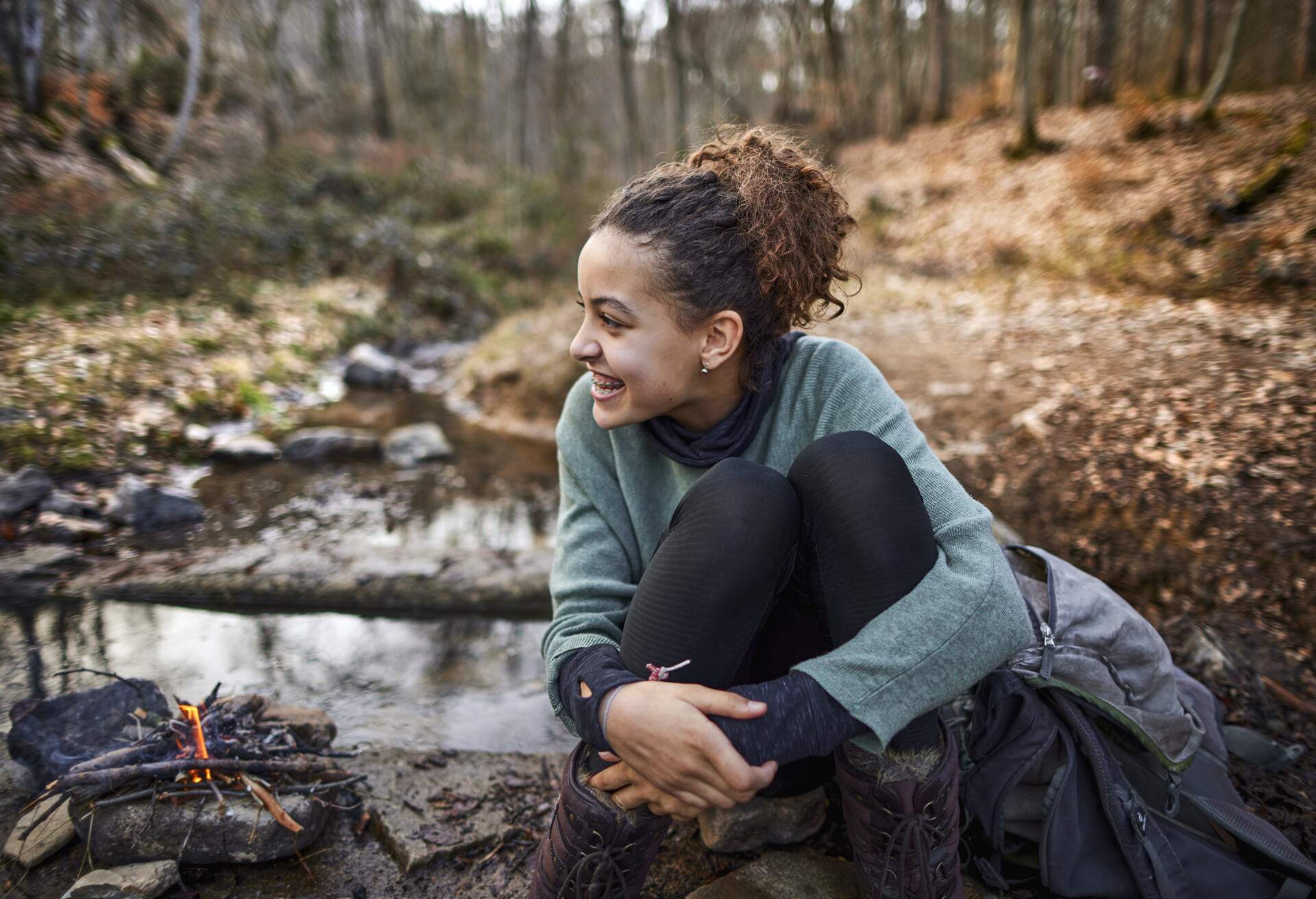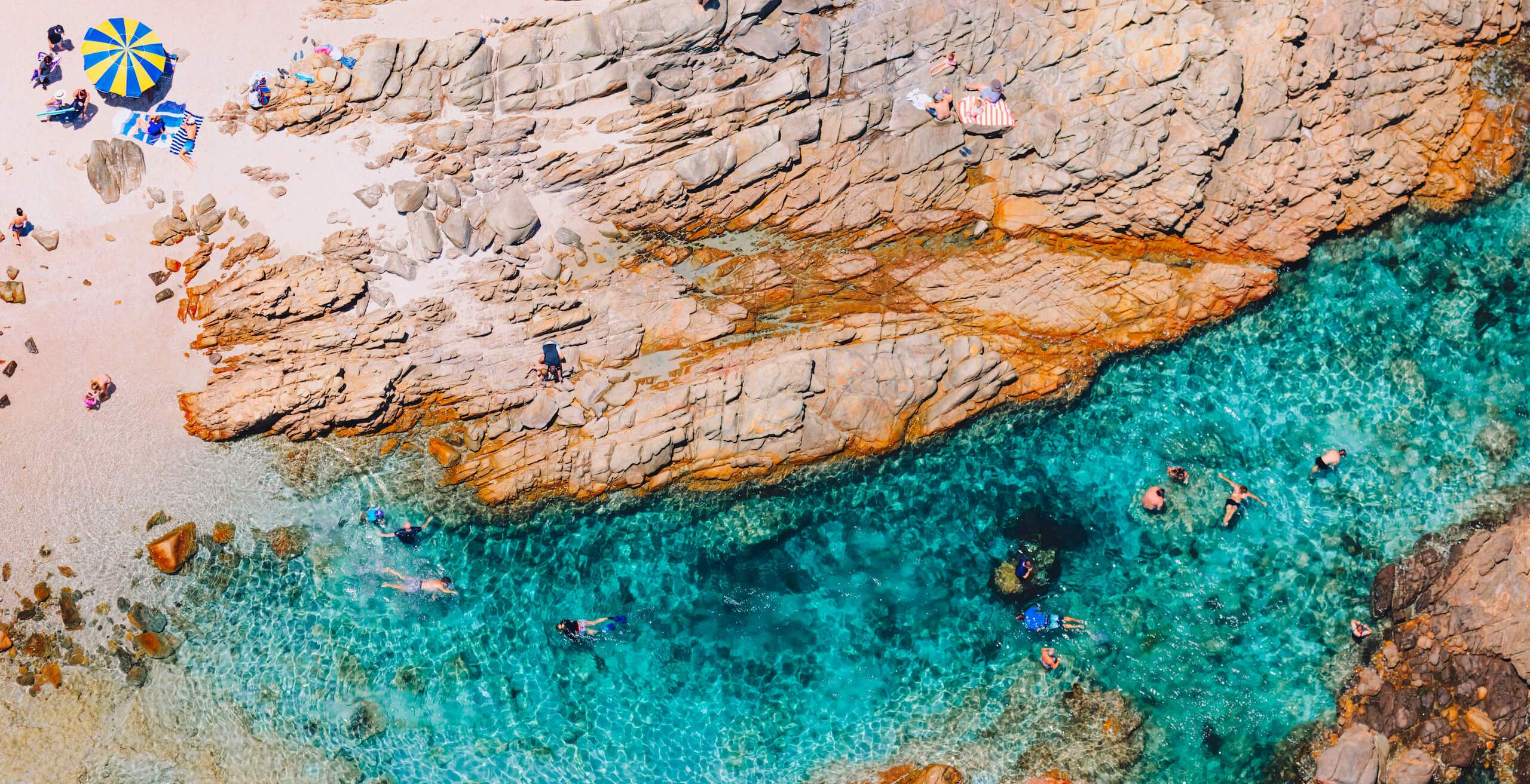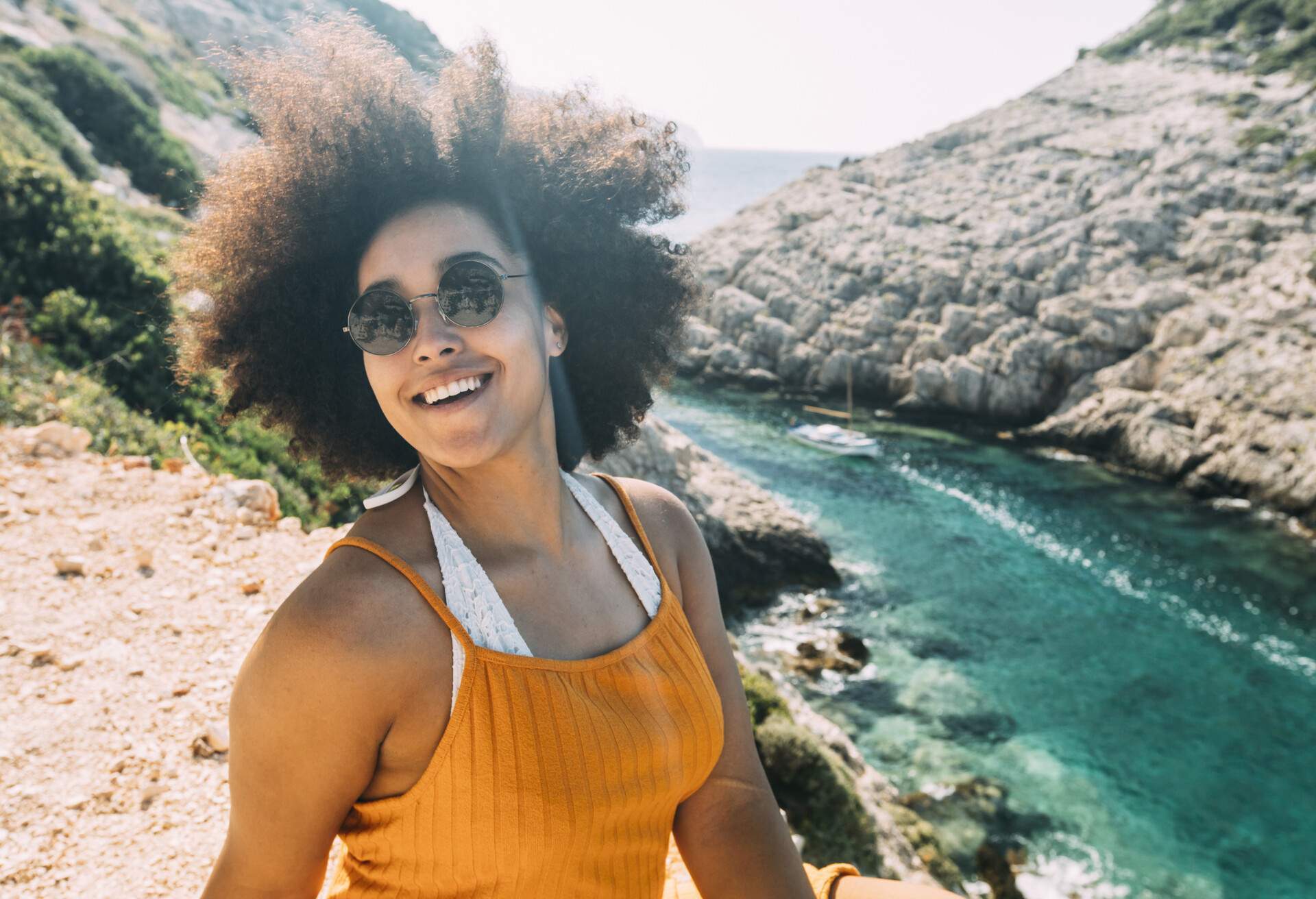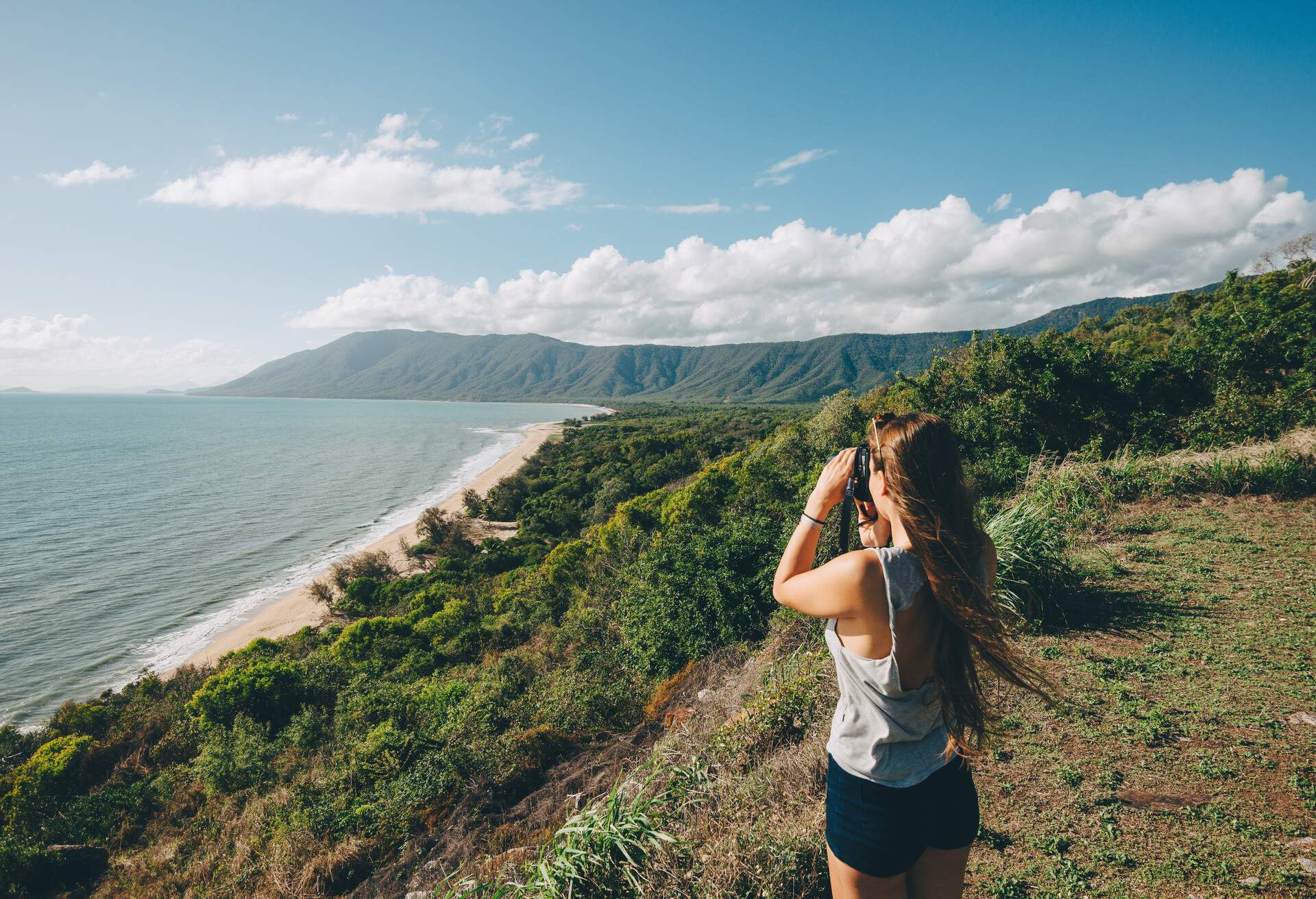Camping in Australia is easy, fun, and unforgettable. With a range of stunning locations all around the country, you can find incredible places to camp wherever and whenever you’re travelling. From basic sites where you can pitch your tent to all-amenities-included glamping experiences, Australia is a camper’s dream.
Camping while you travel: Why you should give it a try!
For many people, overseas travel means hotels, hostels, or holiday rentals, but camping in the great outdoors offers plenty of benefits when you visit another country.
Budget
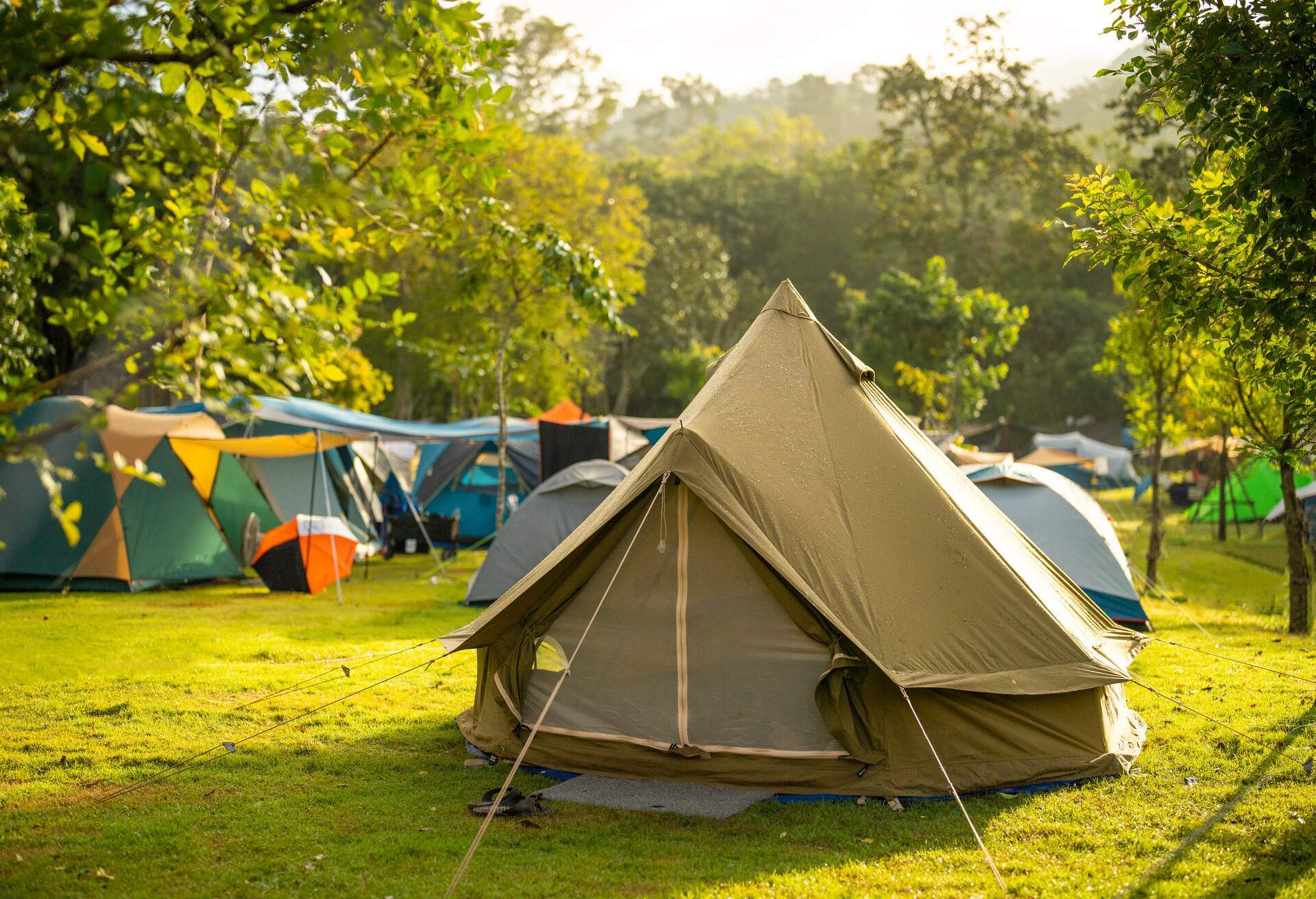
One of the biggest reasons people choose camping is that it can often be a lot cheaper, particularly if you’re travelling solo and don’t have anyone to split hotel room costs. If you can bring your own tent, you only have to pay for a spot to set it up, which can be on par with or cheaper than even hostel dorms (and you get more privacy).
Plus, sometimes you can find camping areas or grounds that are completely free. Camping spots in Australia can cost as little as around A$7 a night; powered sites average around A$50 a night, while glamping sites can cost around A$200 a night or more.
Read also: Everything you need to know to plan your next holiday backpacking in Australia
Explore nature
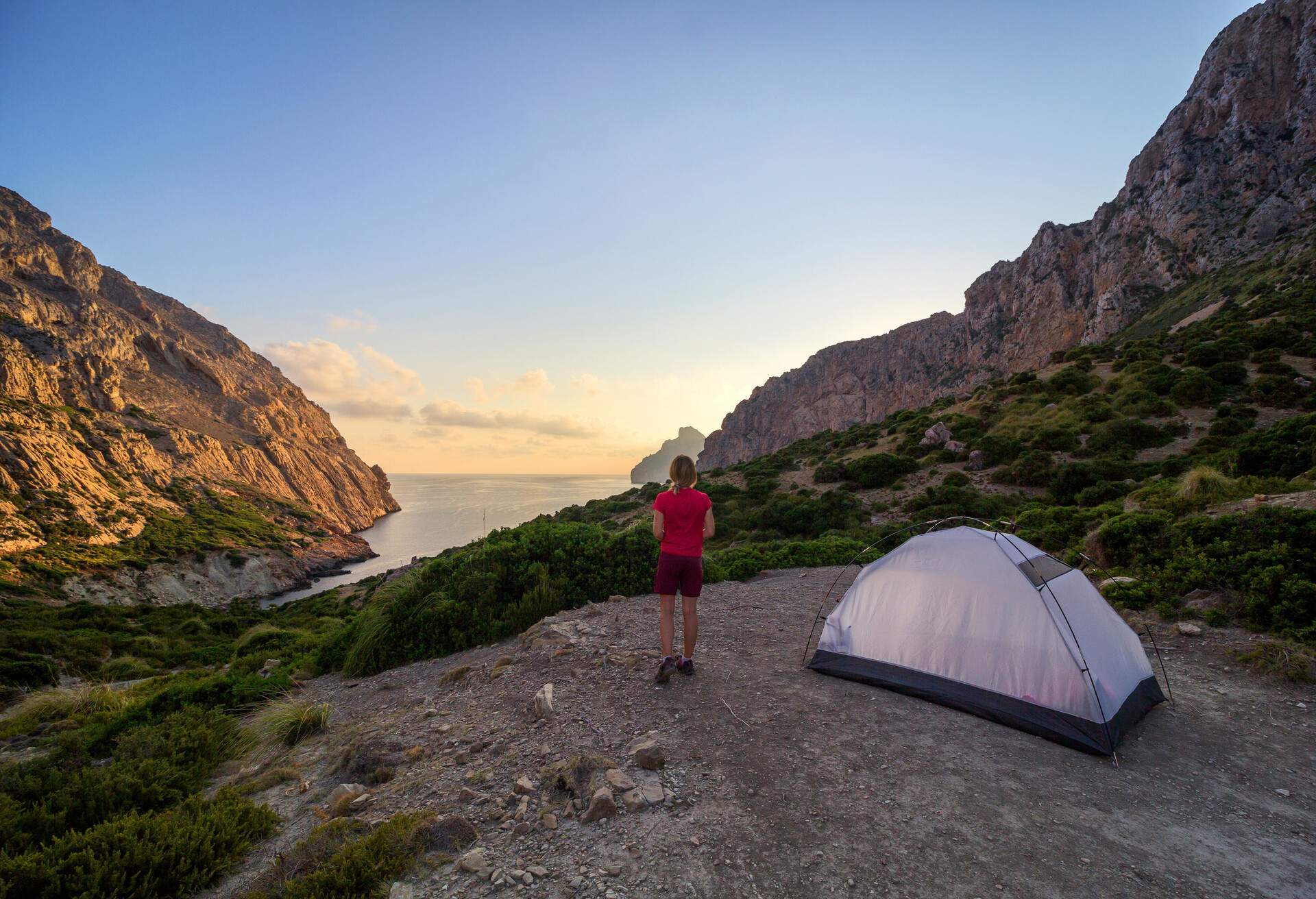
Camping takes you away from the big cities and out into the countryside, where you can experience stunning natural landscapes. Even the biggest city lover can appreciate the simple joy of being able to gaze up at a night sky full of stars.
Even inexperienced campers can have a great trip
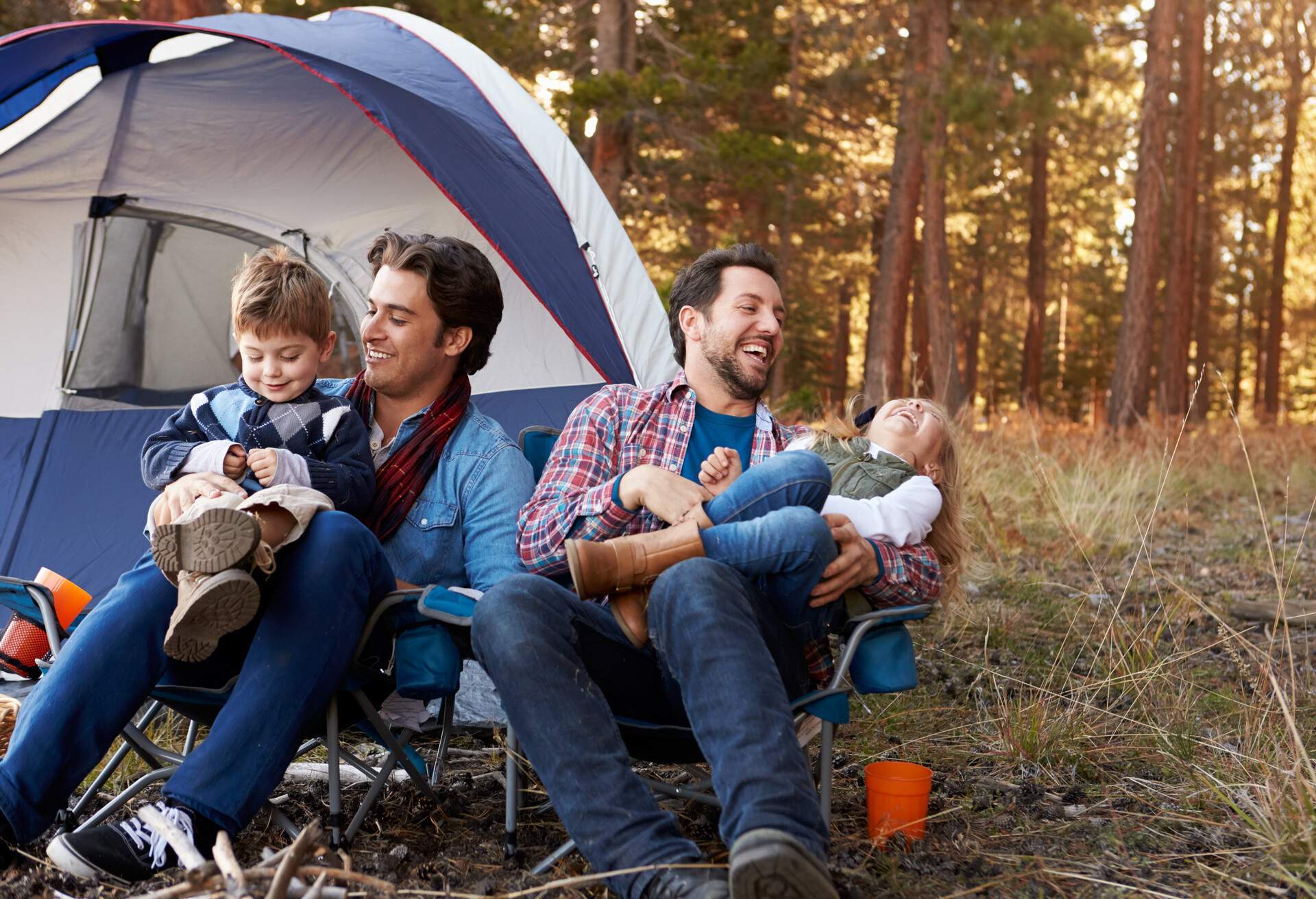
Once upon a time, if you wanted to go camping, you needed your own gear, and you needed to know what to do with it. These days there are a wide variety of camping grounds with different options available, including simple campsites that let you rent tents, help you set them up, and provide facilities like kitchens, toilets, and showers. At the fancier end of the scale, more and more glamping sites are cropping up every day, which provide large, luxurious tents and plenty of amenities, including catering and heating.
Camping in Australia
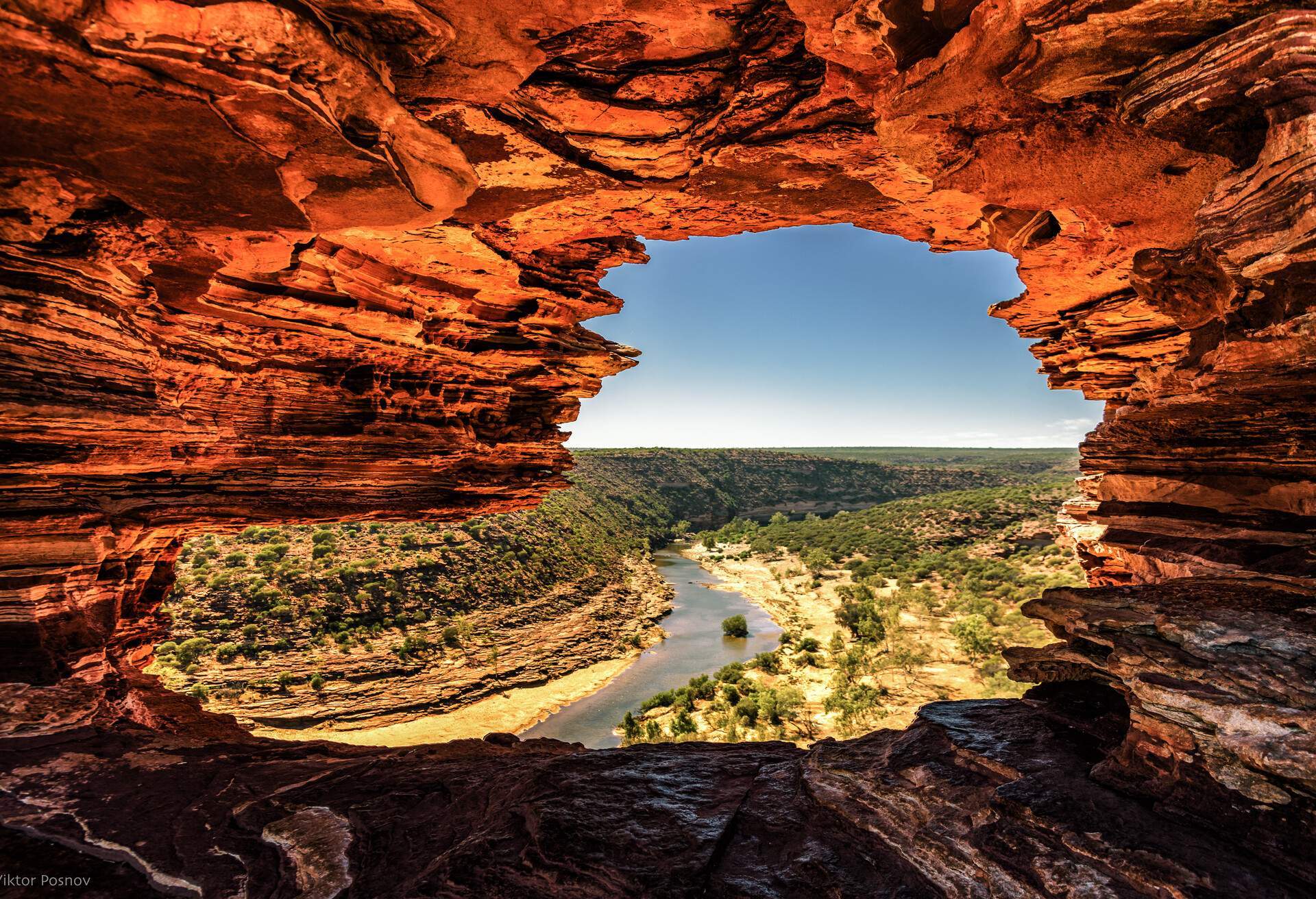
Australia has some of the most beautiful landscapes in the world. From lush rainforests to dramatic coastlines, Australia’s best camping places will put you at the heart of these natural phenomena. Note that wild camping is illegal in Australia, but you’ll find no shortage of excellent camping grounds in remote places. Caravan trips are particularly popular in Australia, so you’ll find caravan parks all over the country, particularly along the coastline. Parks usually have spaces for caravans, tents, and small, self-contained cabins.
When to visit
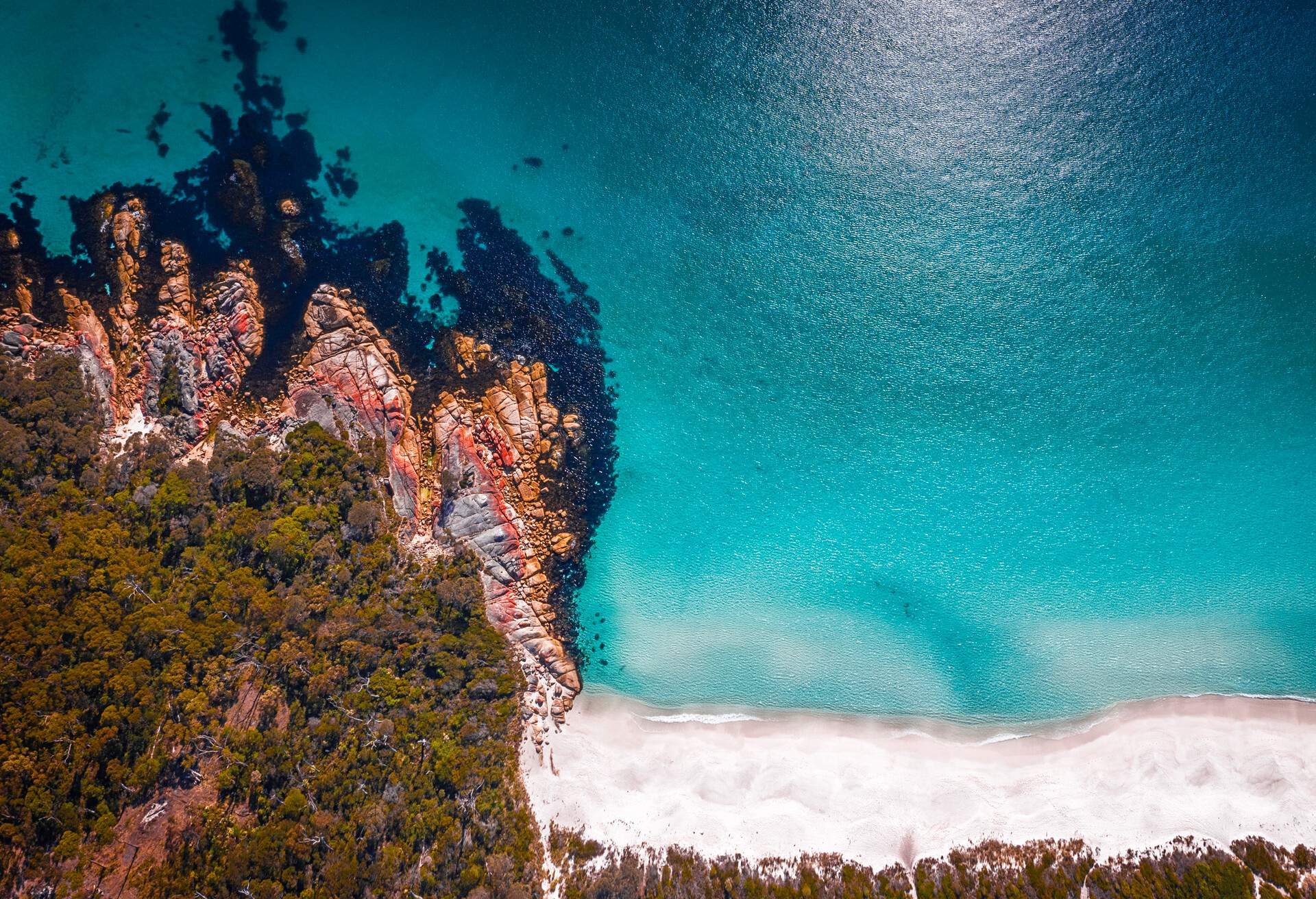
Australia is a beautiful country throughout the year, but the best time to camp is usually in winter and spring if you’re visiting the northern end of the country (Northern Territory, Queensland, and Northern Western Australia). The southern end of the country (Victoria, New South Wales, Tasmania, and South Australia) is best in spring, summer, and autumn. It’s also a good idea to check the school holiday dates for whichever state or territory you’re visiting, as camping grounds will usually be much busier during these times, particularly during summer.
What to bring
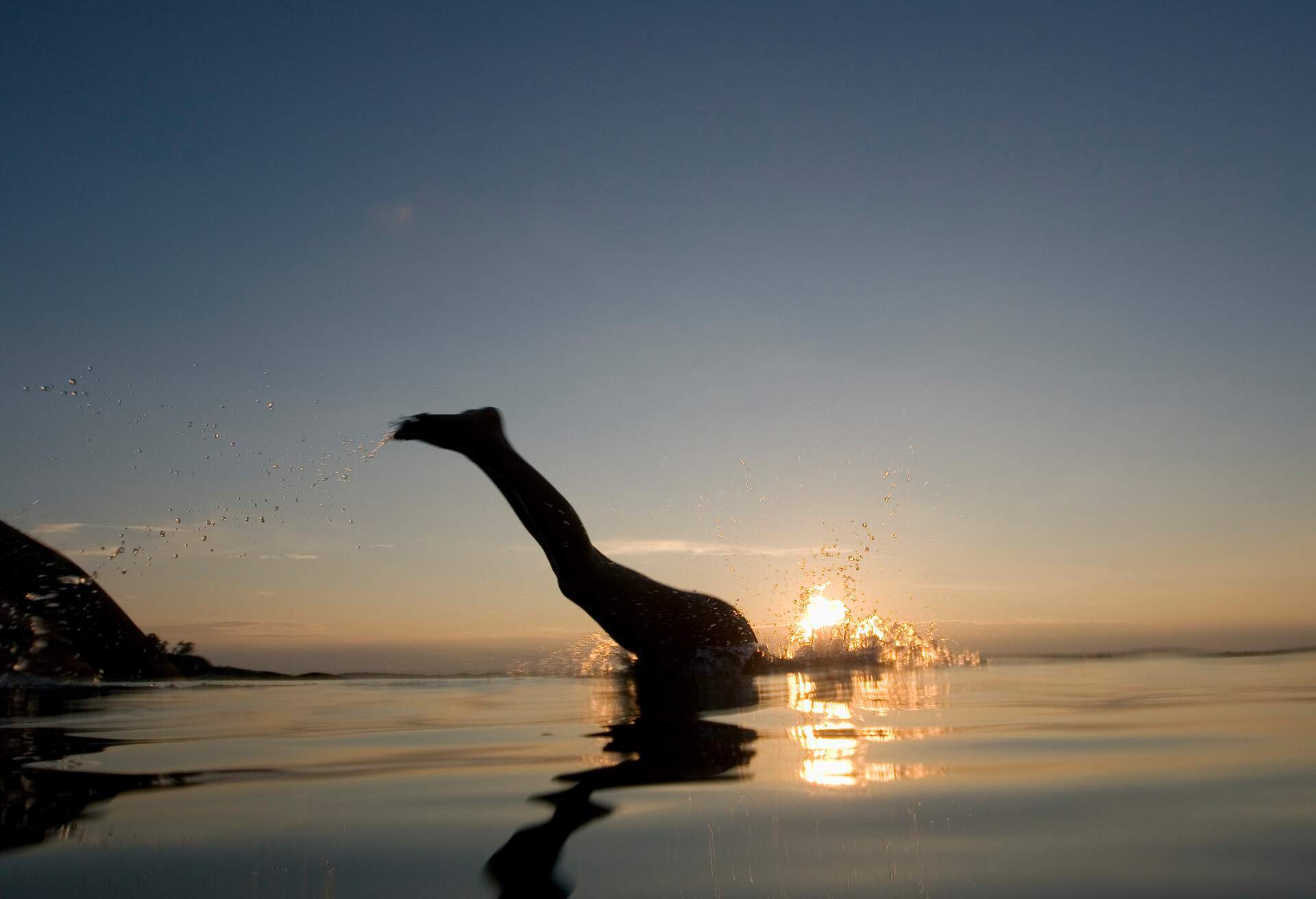
If you’re camping anywhere along the coastline of Australia or near any clean rivers and lakes, make sure you don’t forget your swimwear. The southern beaches of Australia can stay quite cool, even during summer. If you’re an avid swimmer or surfer and plan on taking a dip during cooler weather, consider bringing a wetsuit or spring suit for a bit of extra warmth in the water. Otherwise, you’ll need comfortable clothes and shoes, any necessary gear not provided at your campsite, and don’t forget a good hat and sunglasses, especially if you’re going in summer.
Suffolk Beachfront Holiday Park, Byron Bay, New South Wales
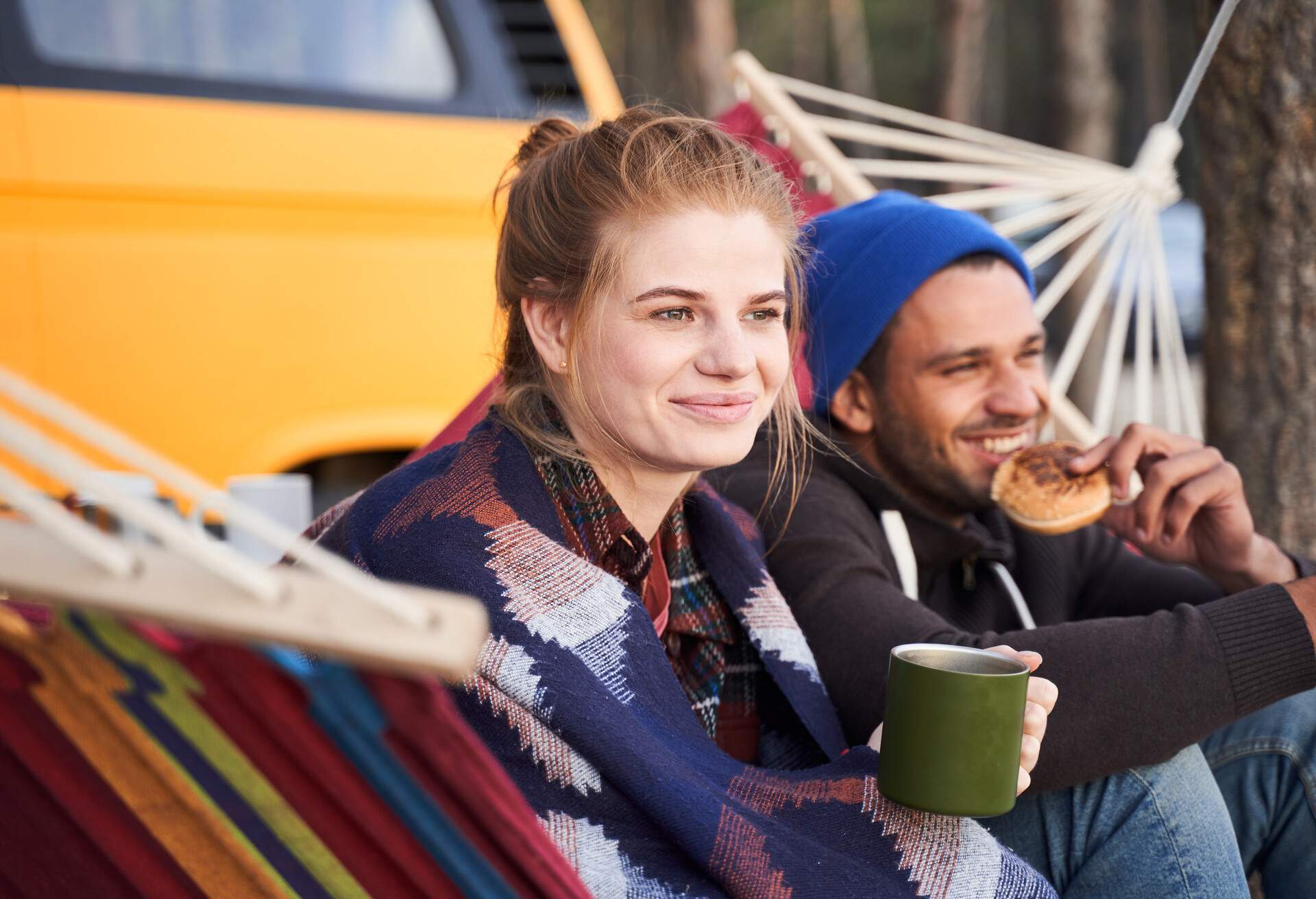
Byron Bay is one of Australia’s most well-known coastal retreats, and the Suffolk Beachfront Holiday Park to the south of Byron Bay is the perfect way to experience the region in a bit more peace and quiet. The campsite has spots for tents and caravans along the beachfront, and they can also provide safari tents that fit up to six people, and self-contained cabins are available to rent.
Fall asleep to the sounds of crashing waves and wake up with the sunrise before experiencing local food, markets, and seaside adventures like kayaking, skydiving, and more. The park has free barbecue facilities, a modern camp kitchen, outdoor and undercover dining areas, laundry facilities, free Wi-Fi, and private beach access.
Cockatoo Island, New South Wales
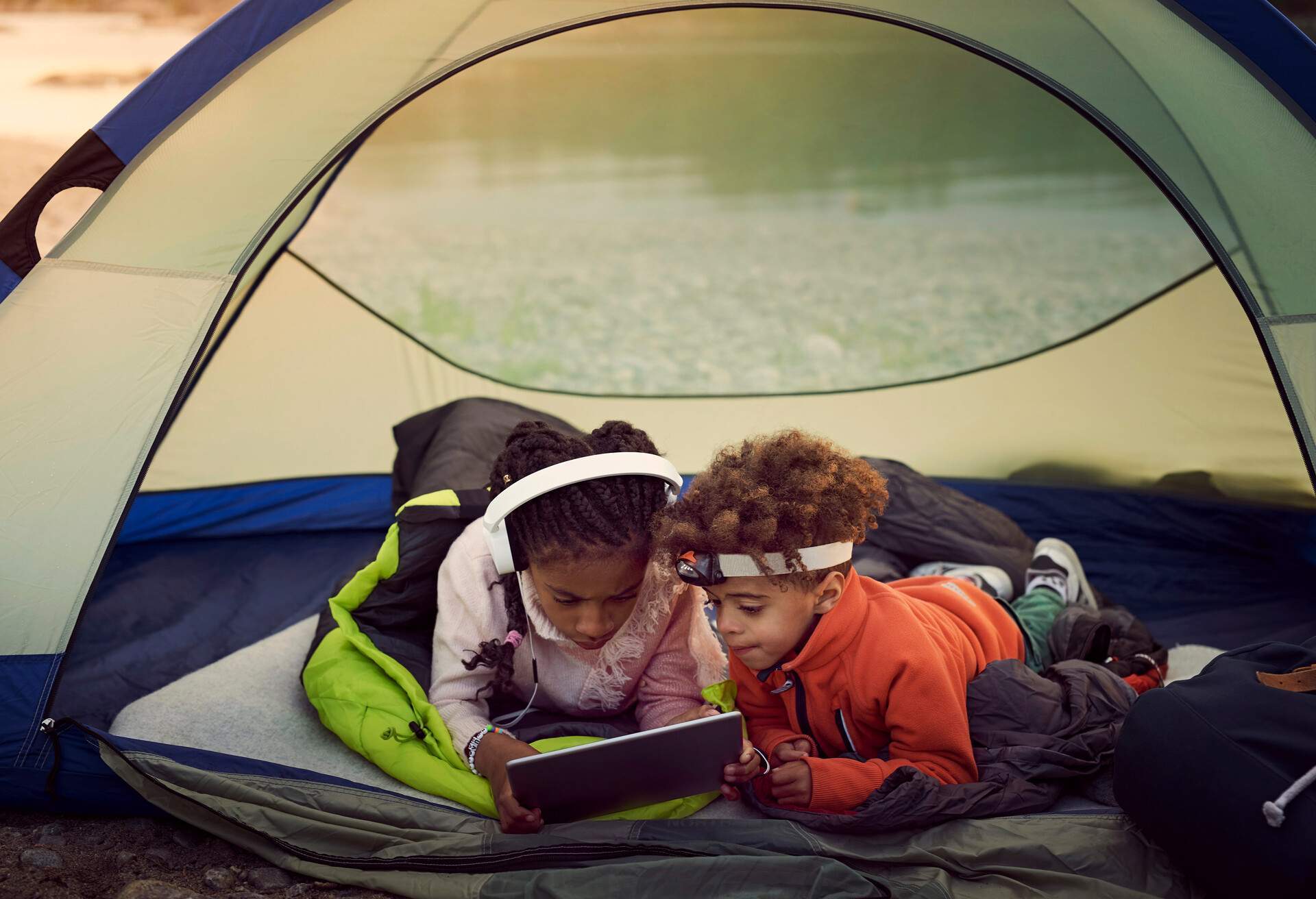
Situated in Sydney Harbour, Cockatoo Island is a UNESCO World Heritage Site home to historic buildings, unique terrain, and an abundance of excellent waterfront cafes and picnic spots. Their waterfront campground includes toilets, hot showers, a communal kitchen with fridges, microwaves, boiling water, and laundry facilities. It has rates available for a range of budgets with the option to purchase a just camping site or to choose a pre-furnished tent, with some situated directly on the waterfront. You’ll get stunning views of Sydney Harbour and the opportunity to explore this beautiful island at your own pace.
Green Patch, Booderee National Park, Sydney, New South Wales
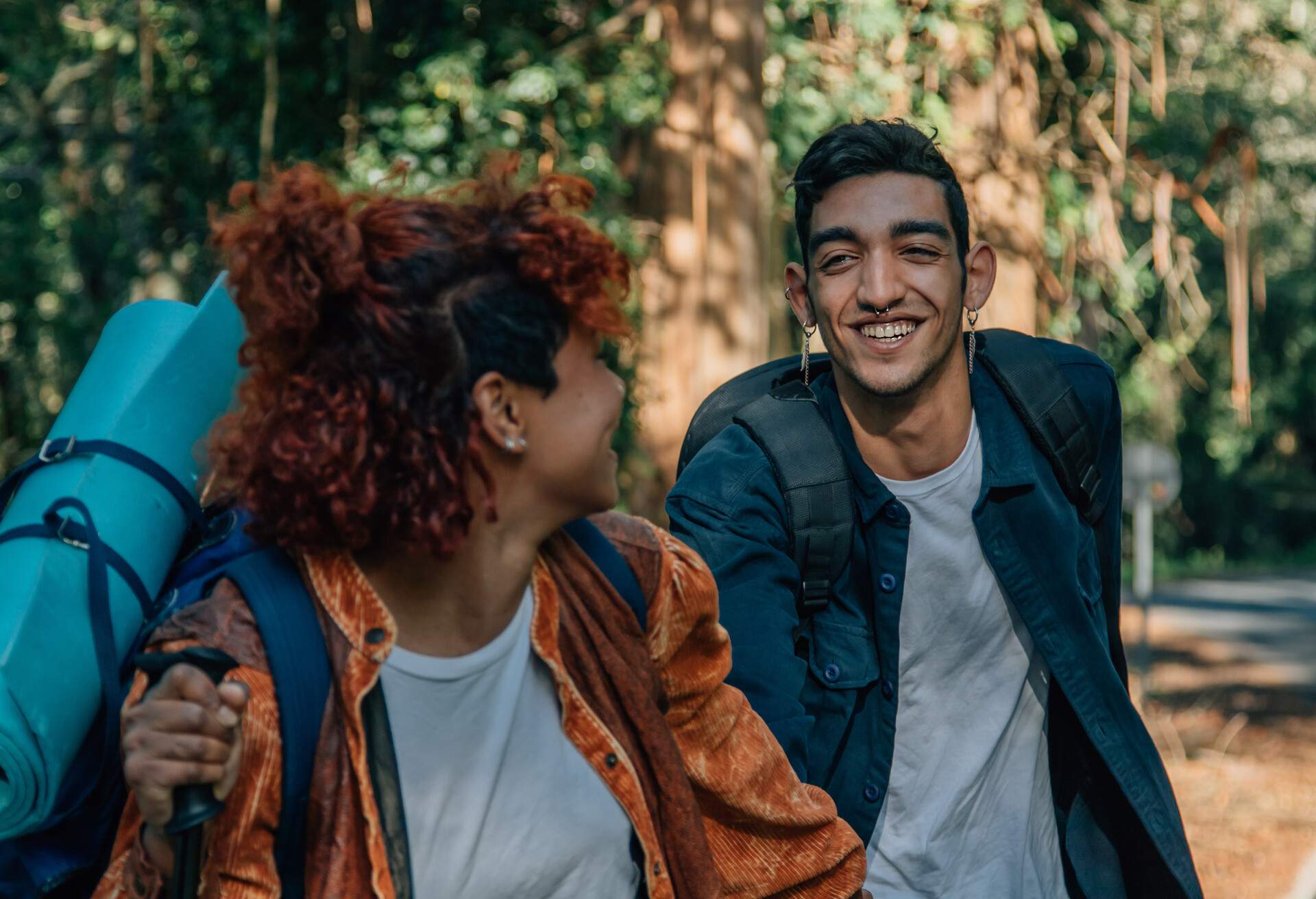
Booderee National Park is home to dense forests, white sand beaches, and stunning high cliffs that provide scenic views of the Pacific Ocean. Green Patch provides unpowered campsites in a range of sizes to suit both tents and campervans close to Green Patch Beach, a peaceful lagoon sheltered by trees. The site has fresh water, public toilets, hot water showers, and barbecues with shelters. The campsite can book out up to a month in advance, particularly between October and May on weekends, so make sure you book ahead of time to avoid disappointment.
Habitat Noosa Everglades Ecocamp, Noosa, Queensland
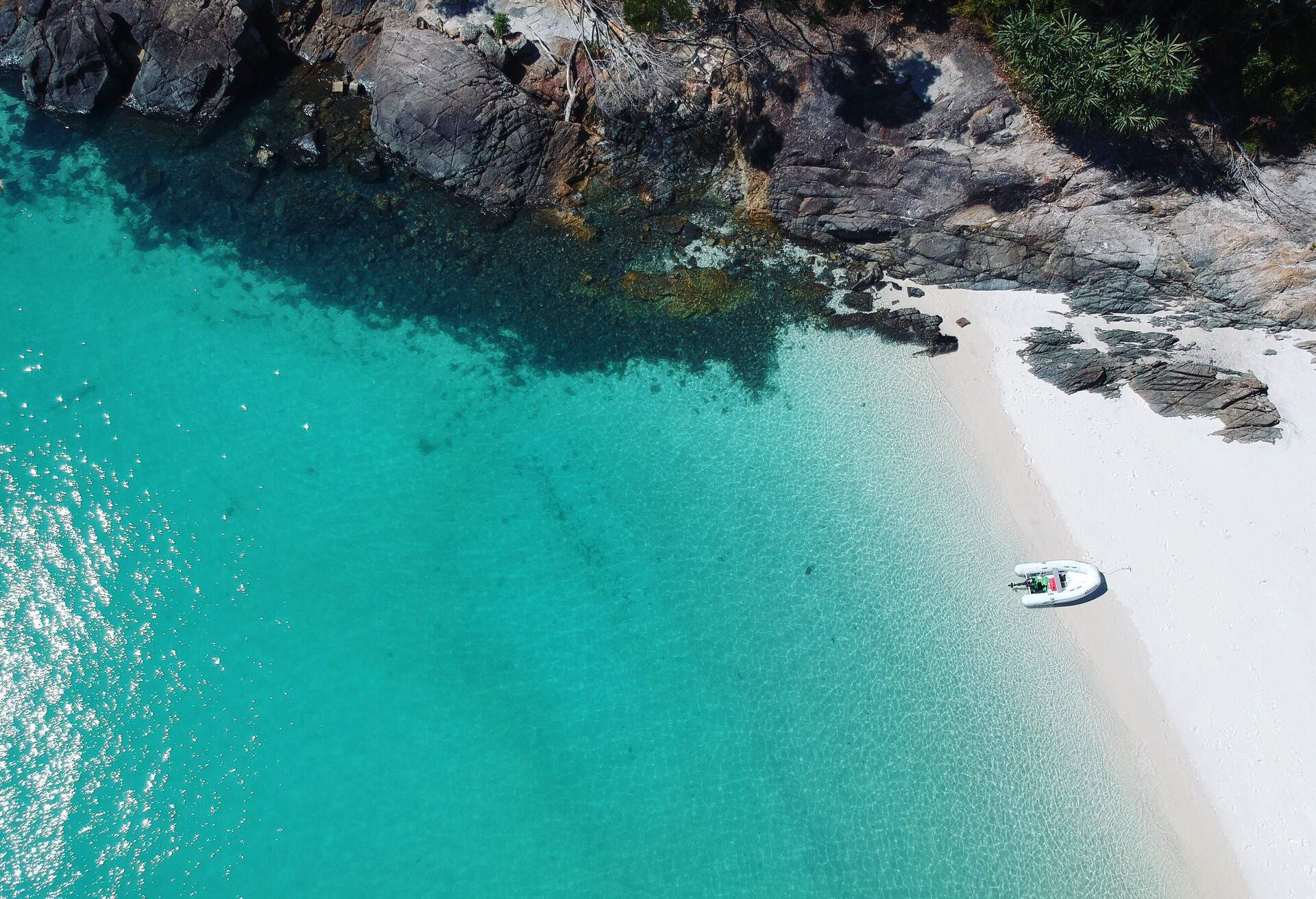
Noosa is one of Australia’s most popular resort towns. Just a little outside the town, you’ll find the Noosa Everglades, a region full of beautiful beaches, quiet woodland, peaceful freshwater lakes, and the Noosa River. Habitat Noosa Everglades Ecocamp provides powered and unpowered camping spots as well as all-weather glamping tents on their 26-hectare property that sits alongside the Noosa River. The site has a camp kitchen with barbecues, a fridge, a microwave, a kettle, and a hot water washing area, but you should note that the site does not supply cooking utensils and crockery.
Cylinder Beach Camping Ground, Minjerribah, Queensland
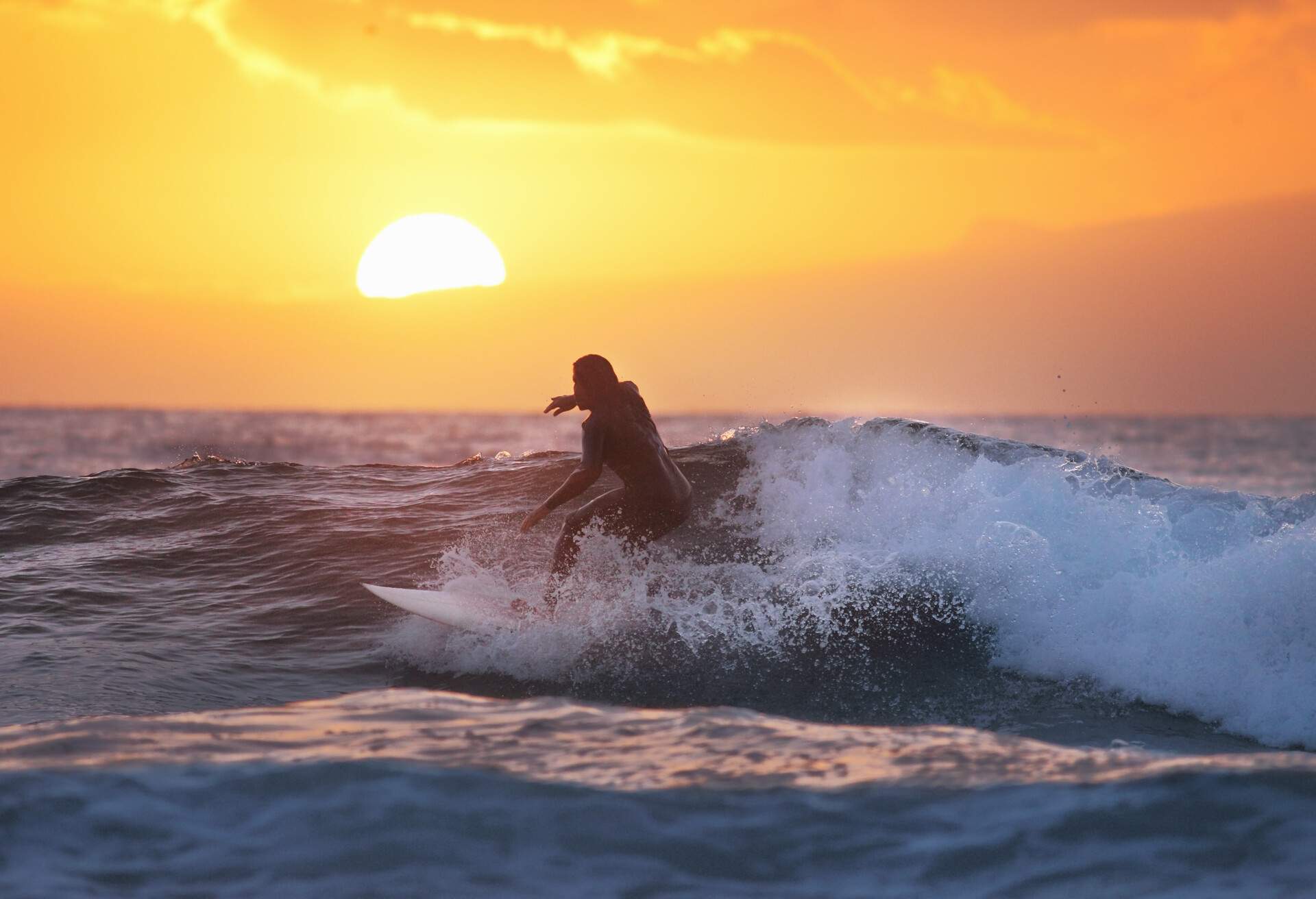
Minjerribah Island is easily accessible from Brisbane. It’s a beautiful island with excellent beaches (especially for surfing), scenic walking trails, and wild kangaroos. Cylinder Beach Camping Ground sits opposite one of Minjerribah’s best beaches. It is close to cafes, restaurants, and a convenience store, so you’ll get a perfect balance of nature and modern living. It has drinking water, toilets, hot showers, coin-operated laundry, free Wi-Fi, and offers eight powered van sites.
Nightfall Wilderness Camp, Lamington National Park, Queensland
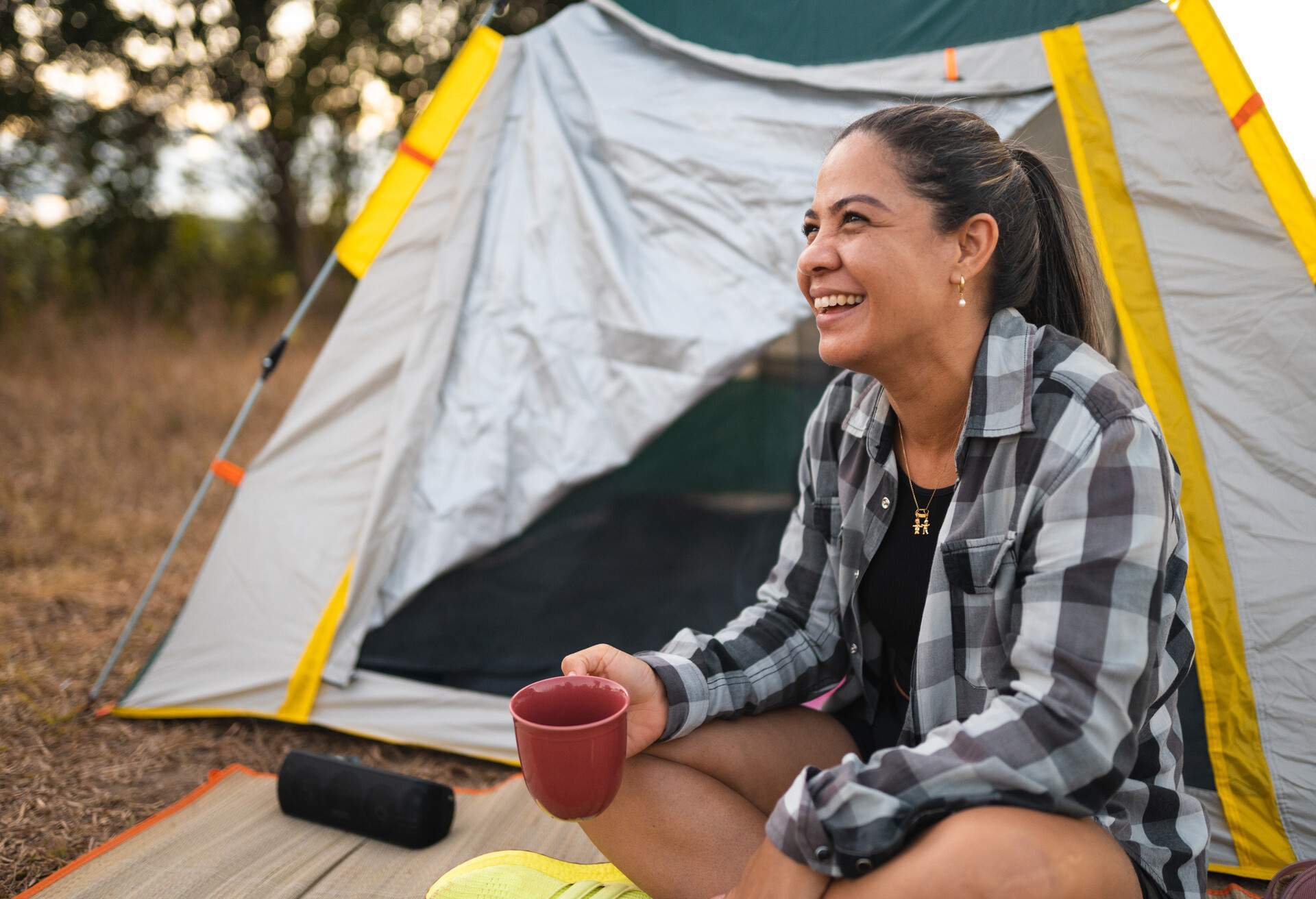
If you’re after an amazing glamping site in Queensland, look no further than the Nightfall Wilderness Camp in Lamington National Park. Use it as a home base to go hiking along the Stinson Plane Wreck hiking trail or just relax in nature away from the hustle and bustle of modern life while still having plenty of home comforts. The camp provides home-cooked organic food, a rotating fireplace, and twin bathtubs in every tent, and activities like massages, facials, yoga classes, and private dining experiences, perfect for couples. The site is popular and only allows eight visitors for overnight stays, so be sure to book well in advance to make sure you secure a spot.
Bay of Fires Bush Retreat, Binalong Bay, Tasmania
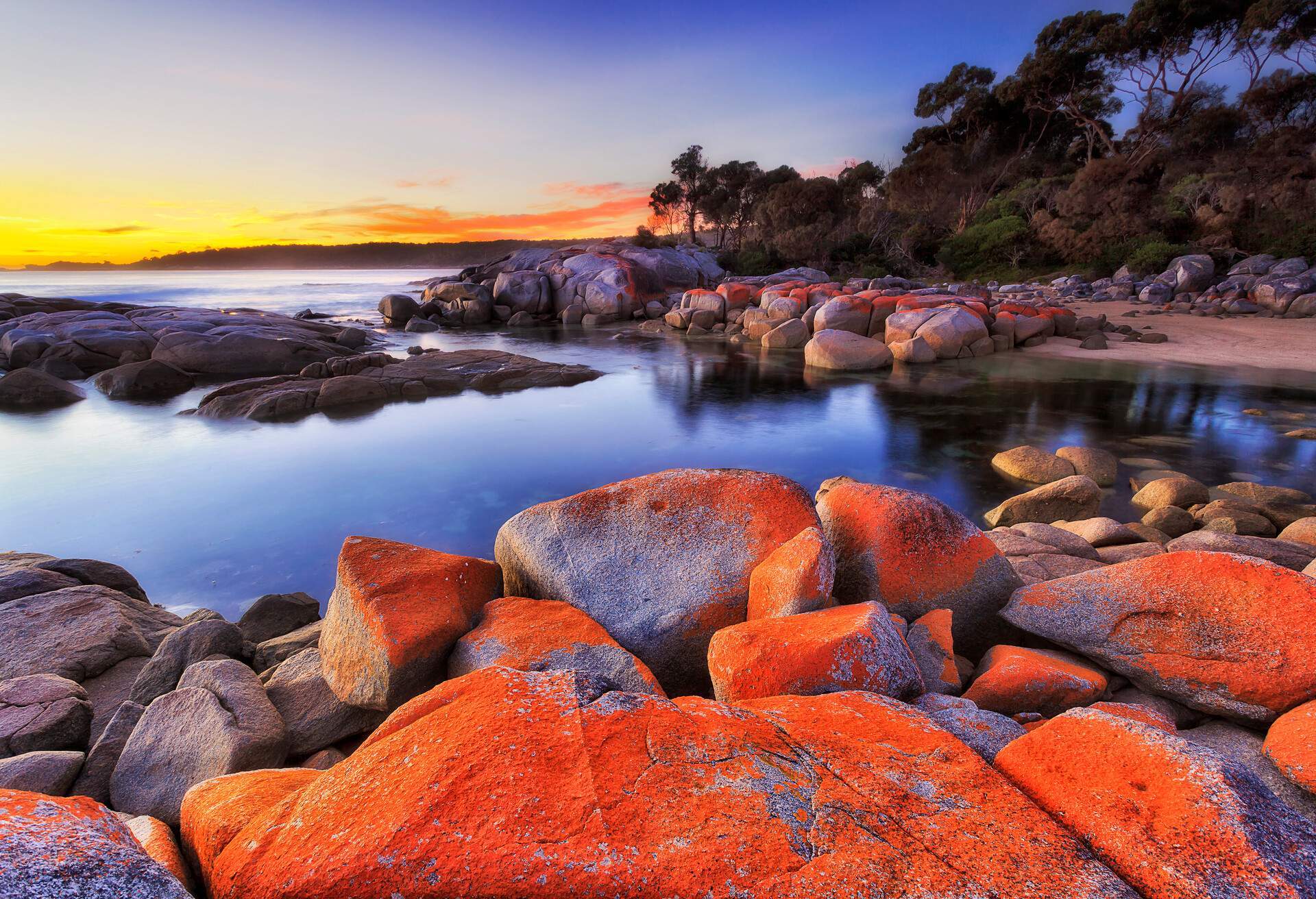
Binalong Bay is a scenic coastal village close to the Bay of Fires, a region renowned for its bright blue ocean waters that meet rocky boulders lined with orange lichen to create a picturesque landscape. The Bay of Fires Bush Retreat is a fantastic glamping experience that lets you disconnect from modern life in luxurious comfort.
They offer tents, bunk houses, and private indoor accommodation (all with bedding and towels provided), and all guests can access the amenities block, including a fully equipped kitchen, toilets, and showers. They can also provide a catered breakfast, and they have an onsite platter with a range of local produce and house-made items, along with a selection of Tasmanian wines and beers.
Cooinda Camping Ground, Kakadu National Park, Northern Territory
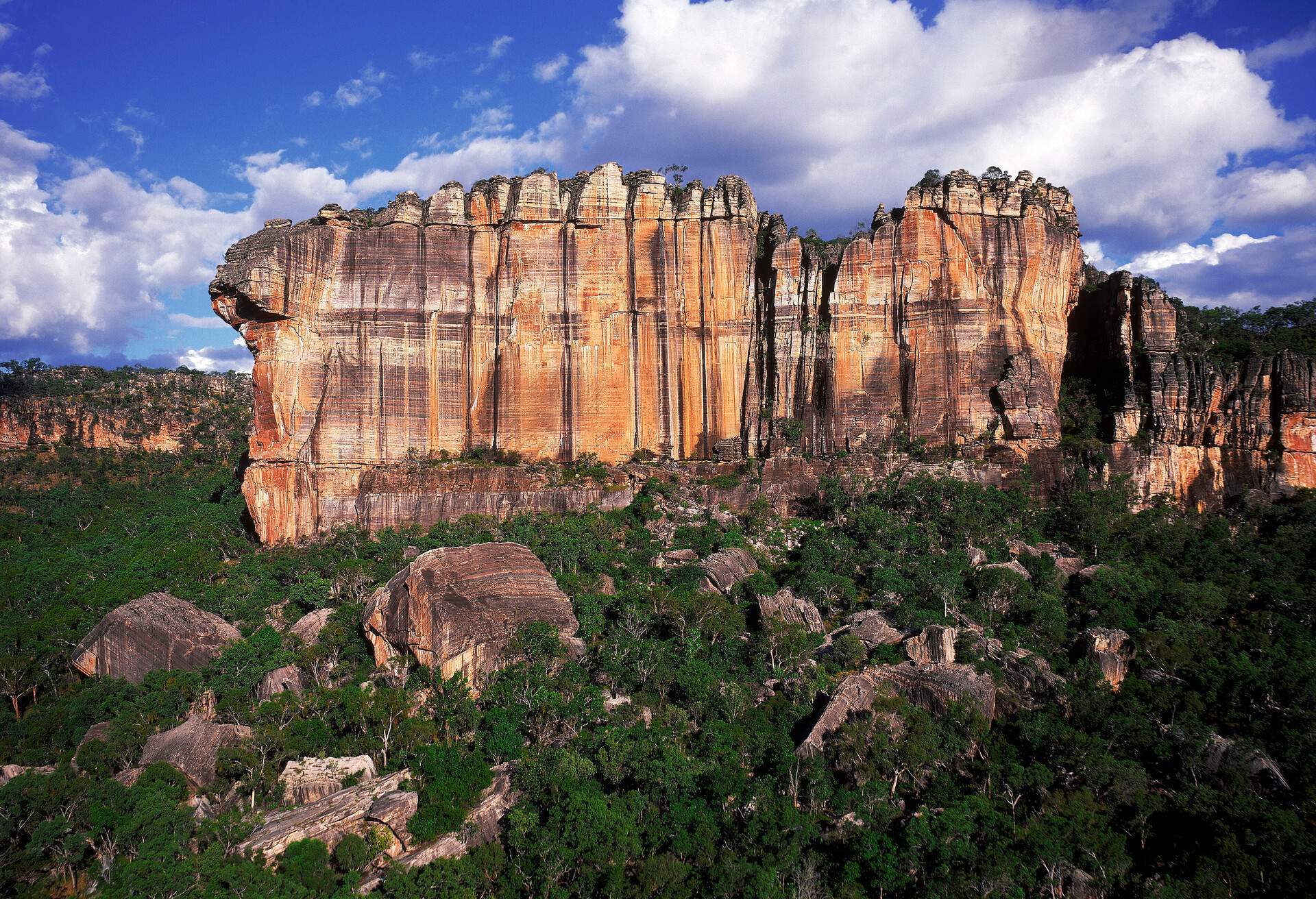
Kakadu is Australia’s biggest national park, home to thick rainforests, stunning waterfalls, and 20,000-year-old rock art galleries. The Cooinda Camping Ground is right next door to one of Kakadu’s most beautiful sights, the Yellow Water Billabong in the South Alligator river floodplain. Hope on board a Yellow Water cruise and glimpse the region’s incredible wildlife and scenic landscapes. The site includes both basic tent spaces and powered sites along with a pool, restaurant, laundry facilities, petrol, and even a small gift shop.
Refuge Cove, Wilsons Promontory, Victoria
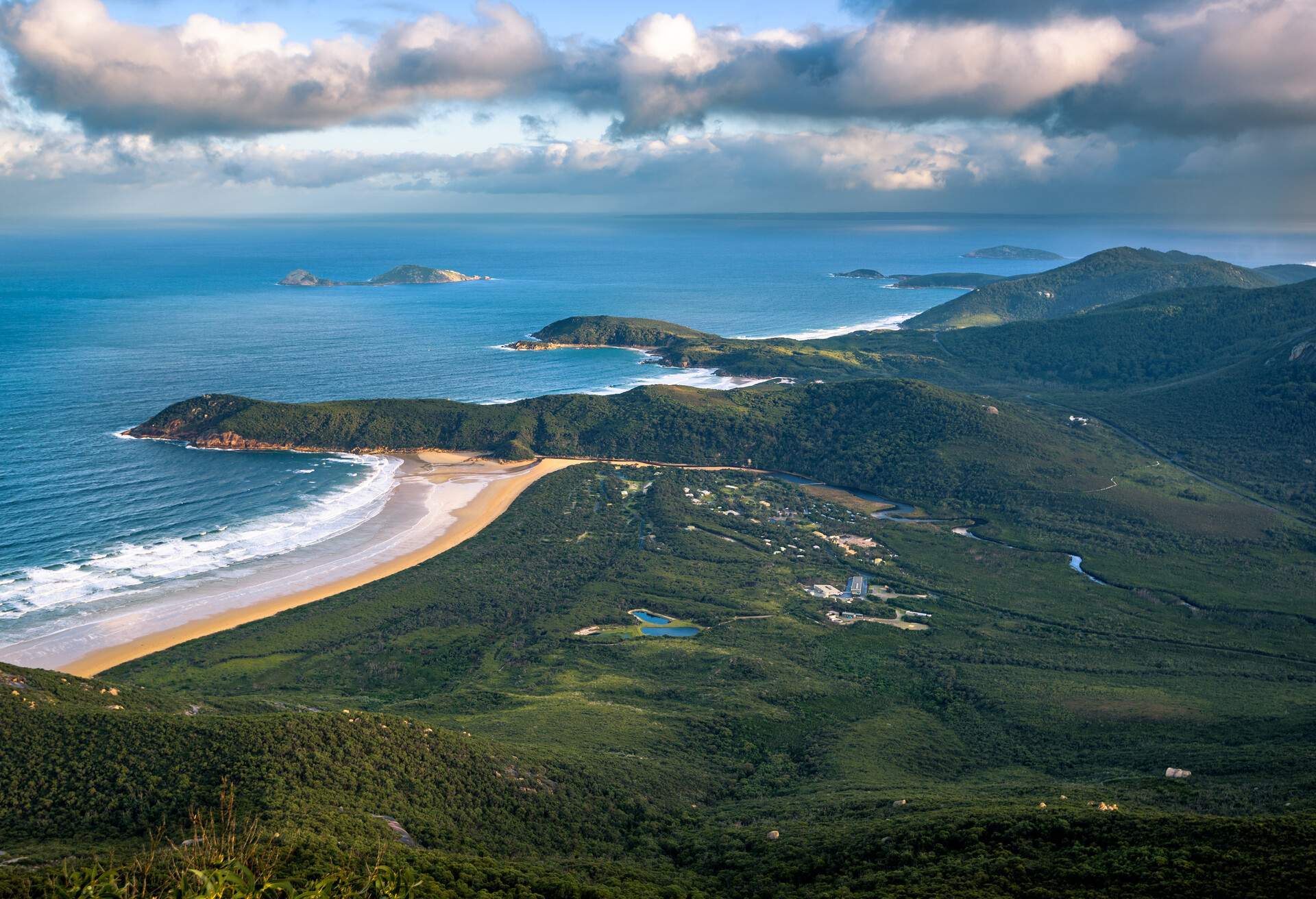
You’ll need to hike in to reach this beautiful, secluded beach on the eastern side of Wilsons Promontory, and once you arrive, you’ll be met with lush vegetation and the sound of crashing waves. There are two walking tracks, one to the north, which begins at Sealers Cove, and one to the south, which begins at Waterloo Bay, and both hikes take around two hours. You can also sail into the Cove and anchor safely in the water. There are toilets available in the camping area, and there is also untreated creek water, which you must treat before consumption.
Homestead Campgrounds, Dirk Hartog Island, Western Australia
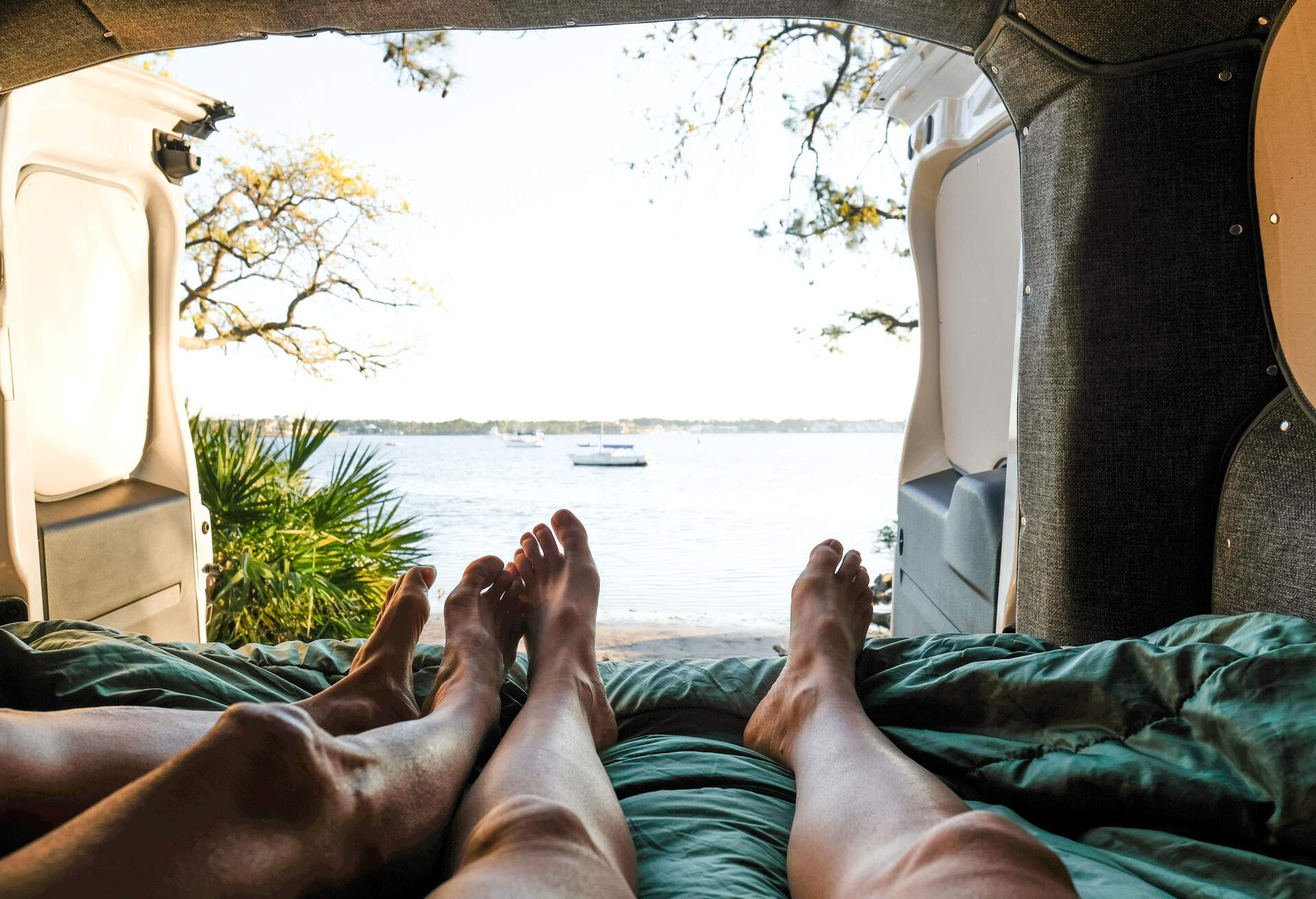
Homestead Campgrounds operates on a first-come, first-served basis, and during the peak holiday season, we recommend you contact the campground before you leave to check availability. Dirk Hartog Island is a lovely, small island off the coast of Western Australia and sits within the Shark Bay World Heritage Area.
The campground itself is located near the barge that transports visitors to and from the island and has picnic tables, toilets, shower facilities, untreated water, and fire rings (campfires are only permitted in the fire rings between March and October, subject to fire restrictions). You’ll be close to the beach, so you can easily spend your days relaxing in the water or exploring the area.
